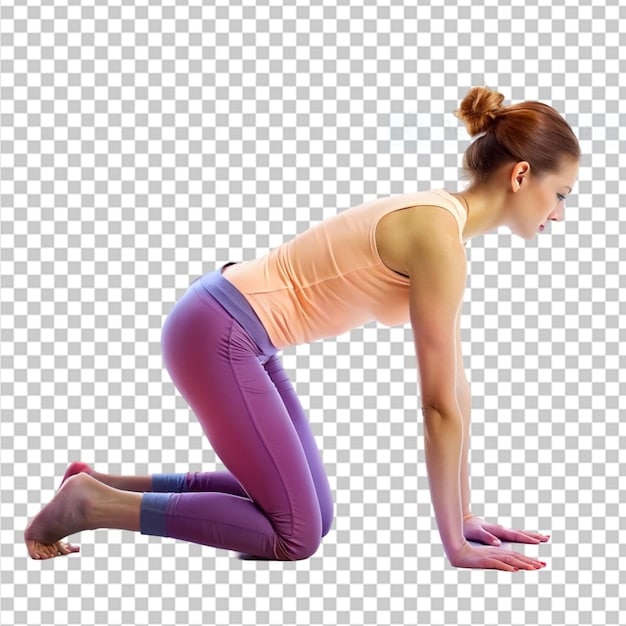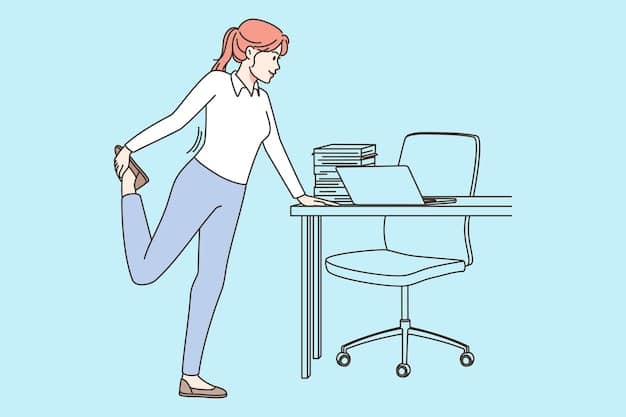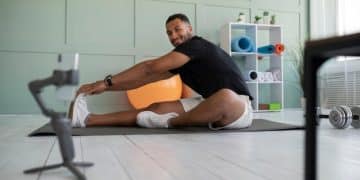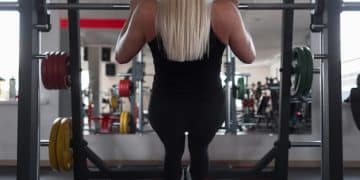Mobility Matters: Daily Stretches for Injury Prevention & Performance

Achieving optimal physical performance and preventing injuries critically depends on prioritizing daily mobility stretches, as they enhance joint range of motion, improve muscle elasticity, and support overall bodily resilience.
In the dynamic pursuits of daily life and athletic endeavors, the phrase Mobility Matters: Daily Stretches to Prevent Injuries and Improve Performance resonates deeply. Far from a mere luxury, incorporating targeted stretching into your routine is a foundational element for anyone seeking to optimize physical function, mitigate injury risk, and unlock their full potential. This isn’t just about touching your toes; it’s about fostering a body that moves with freedom, efficiency, and enduring strength.
The foundational role of mobility in physical health and athletic performance
Mobility, often confused with flexibility, is far more encompassing. It refers to the ability of a joint to move actively through its full range of motion. This involves not only the extensibility of muscles but also the health of connective tissues, joint capsules, and the neurological control that coordinates movement. Lacking adequate mobility can compromise everything from lifting a heavy object to simply bending down to tie your shoes, creating a cascade of inefficiencies and pain points.
For athletes, the implications are even more profound. Restricted mobility can limit power output, reduce speed, and increase susceptibility to strains, sprains, and more chronic conditions. Imagine a pitcher with limited shoulder mobility; their throwing velocity might decrease, and the risk of rotator cuff injuries would soar. Similarly, a runner with tight hips and hamstrings will find their stride compromised, leading to potential knee or lower back issues. Prioritizing mobility allows the body to express its full athletic potential safely and effectively.
Understanding the difference: flexibility vs. mobility
While often used interchangeably, flexibility and mobility are distinct yet interconnected concepts. Flexibility is the passive ability of a muscle to lengthen and allow a joint to move through a range of motion. Mobility, however, adds an active component—the ability to control that range of motion by engaging surrounding muscles. Think of it this way:
- Flexibility: How far you can stretch your leg behind you if pulled by someone else.
- Mobility: How far you can actively lift and control your leg behind you using your own muscles.
Both are crucial, but mobility ensures you have usable range of motion, not just passive extension. Focusing solely on flexibility without developing the strength and control to use that new range can actually make you more vulnerable to injury. True mobility combines both the pliability of tissues with the stability and strength to navigate complex movements.
Moreover, age and lifestyle often contribute to declining mobility. Sedentary jobs, prolonged sitting, and a lack of varied movement patterns can all lead to stiff joints and shortened muscles. Counteracting these modern tendencies requires a proactive approach, identifying areas of restriction and systematically working to restore optimal function. The journey to improved mobility is not about becoming a contortionist; it’s about reclaiming the natural, efficient movement patterns our bodies are designed for, enhancing both longevity and quality of life.
The science behind daily stretching and injury prevention
The link between consistent stretching and injury prevention is supported by a growing body of scientific evidence. Regular stretching helps to improve muscle elasticity, which allows muscles to absorb more force without tearing. When muscles are extensible, they are less prone to micro-traumas during sudden movements or intense physical activity. This is particularly vital for dynamic sports where muscles undergo rapid lengthening and shortening cycles.
Stretching also positively impacts connective tissues like tendons and ligaments, making them more resilient. While tendons and ligaments are less elastic than muscles, targeted stretching can enhance their strength and ability to withstand stress. This improved tissue tolerance reduces the risk of sprains and strains, which are common injuries in both athletic and everyday contexts. Furthermore, improved circulation to these tissues, a byproduct of stretching, can aid in nutrient delivery and waste removal, contributing to their overall health and repair capabilities.
How stretching reduces muscle imbalances
Our bodies are complex systems, and often, some muscle groups become tighter or stronger than others due to repetitive movements or prolonged postures. This leads to muscle imbalances, where one muscle might pull more strongly on a joint than its opposing counterpart, creating undue stress and misalignment. For instance, tight hip flexors often accompany weak glutes, leading to an anterior pelvic tilt and lower back pain.
Daily stretching targets these tight muscle groups, gently lengthening them and restoring balance. By releasing tension in overactive muscles, it allows underactive or stretched muscles to function more effectively. This re-establishes optimal joint alignment and movement patterns, distributing stress more evenly across the body and reducing compensatory movements that can lead to injury. For example, consistent hamstring stretches can alleviate tension that pulls on the pelvis, thereby reducing strain on the lower back.
Additionally, research suggests that proprioception, the body’s awareness of its position in space, is enhanced through stretching. Improved proprioception means better coordination and balance, allowing for quicker reactions to unexpected movements and a reduced likelihood of missteps or falls. This neurological benefit is particularly critical for athletes who rely on precise movements and rapid changes in direction, where even a slight miscalculation can result in injury.
The cumulative effect of daily stretching—enhanced muscle elasticity, resilient connective tissues, corrected muscle imbalances, and improved proprioception—creates a more adaptable and robust physical system. It’s an investment in your body’s longevity, reducing the cumulative wear and tear that can lead to chronic pain and significant injuries over time. While acute injuries may still occur, a body that moves with greater freedom and balance is inherently more resilient and capable of recovering more swiftly than one constrained by stiffness and imbalance.
Key stretches for comprehensive mobility
Implementing a daily stretching routine doesn’t need to be overly complicated. A few carefully selected stretches can provide significant benefits across major muscle groups and joints. The key is consistency and proper form. Focus on gentle, controlled movements, holding stretches without bouncing, and breathing deeply throughout. Listen to your body and never stretch to the point of pain.
Upper body and core mobility
Targeting the upper body and core is essential for posture, overhead movements, and spinal health. Many daily activities and exercises put stress on these areas, making them prone to tightness. Incorporating stretches that open the chest, mobilize the shoulders, and enhance spinal rotation can counteract the effects of prolonged sitting and repetitive motions.
- Doorway Chest Stretch: Stand in a doorway, place forearms on the frame with elbows bent at 90 degrees. Lean forward gently until you feel a stretch across your chest and front of the shoulders. Holds for 30 seconds, 2-3 sets. This opens up the pectoral muscles, which can become tight from sitting or lifting weights.
- Thread the Needle: Start on all fours. Thread one arm underneath your body, palm facing up, resting your shoulder and ear on the floor. Hold for 30 seconds per side, 2-3 sets. Excellent for thoracic spine rotation and shoulder mobility.
- Cat-Cow Stretch: On all fours, gently arch your back, dropping your belly towards the floor (cow), then round your spine, tucking your chin to your chest (cat). Flow smoothly between positions for 10-15 repetitions. Improves spinal flexibility and warms up the back muscles.
These stretches help address common areas of stiffness, contributing to better posture and reducing strain on the neck and shoulders. Consistency is key; even a few minutes each day devoted to these specific movements can yield noticeable improvements in comfort and range of motion.

Lower body and hip mobility
The lower body, particularly the hips and hamstrings, are crucial for virtually all forms of locomotion and athletic performance. Tightness in these areas can lead to issues in the knees, lower back, and even the ankles. Improving lower body mobility is paramount for runners, lifters, and anyone looking to enhance their daily functional movement.
- Pigeon Pose (Modified): Start in a plank position, bring one knee towards your opposite wrist, and let your shin angle across your body. Gently lower your hips. This deeply stretches the hip flexors and glutes. Hold for 30-60 seconds per side, 2-3 sets.
- Hamstring Stretch (Standing or Seated): From a standing position, place one heel on a slightly elevated surface (like a chair) with a straight leg, hinge at the hips, keeping your back straight until you feel a stretch in your hamstring. Alternatively, sit on the floor with legs extended and reach for your toes. Hold for 30 seconds, 2-3 sets per leg.
- Ankle Mobility Circles: Sit with one leg extended. Rotate your ankle clockwise and counter-clockwise 10-15 times in each direction. Then, point and flex your foot. Improves ankle joint health and range of motion, crucial for runners and mitigating foot pain.
Addressing lower body restrictions supports more efficient walking, running, and jumping. It also helps stabilize the pelvis, which can significantly reduce the incidence of lower back pain. Many people underestimate the impact of tight ankles on knee and hip health, highlighting the interconnectedness of our kinematic chain. By targeting these areas, you build a more robust and resilient foundation for movement.
Dynamic vs. static stretching: what’s the difference?
While static stretching (holding a stretch for 20-30 seconds) is excellent for increasing flexibility post-workout or as a standalone mobility routine, dynamic stretching (controlled movements that take your joints through their full range of motion) is best performed before exercise. Dynamic stretches prepare the muscles for activity, increasing blood flow and improving nerve-muscle connection without reducing power output. Examples include leg swings, arm circles, and torso twists.
A balanced approach integrates both. Dynamic mobility work pre-activity warms up the body, while static stretching post-activity helps return muscles to their optimal length and aids recovery. Understanding when to apply each type of stretch maximizes their benefits for performance and injury prevention.
Incorporating mobility into your daily routine
The beauty of mobility work is that it doesn’t require hours in the gym. Small, consistent efforts can yield significant results. The key is to integrate stretches seamlessly into your daily life, making them as routine as brushing your teeth. This consistent exposure to optimal movement patterns gradually reshapes your body’s capabilities, fostering lasting change rather than temporary fixes.
One effective strategy is to perform short stretching sessions throughout the day. For example, spend 5-10 minutes stretching upon waking to gently prepare your body for the day ahead. Incorporate quick stretches during work breaks, especially if you have a sedentary job. Standing up and performing a few simple movements like shoulder rolls, neck tilts, or a gentle spinal twist can counteract the stiffness that accumulates from prolonged sitting. Consider setting reminders on your phone to prompt these mini-mobility breaks.
Morning routine activation
Starting your day with a targeted mobility routine can significantly enhance energy levels and reduce morning stiffness. Focus on large, compound movements that wake up major muscle groups and activate the nervous system. This is not about pushing to your maximum range but rather about gently reminding your body how to move freely after hours of sleep. A simple sequence might include:
- Spinal twists: Lying on your back, knees bent, gently let your knees fall to one side while keeping shoulders flat.
- Light hip circles: While lying, pull one knee to your chest, then gently rotate your hip in circles.
- Arm circles: Stand up and perform large, controlled arm circles both forwards and backward.
These movements increase blood flow, lubricate joints, and improve neural pathways, preparing your body for the demands of the day, whether that involves a workout or simply navigating daily tasks with greater ease. The goal is to move, not to stretch aggressively.
Mid-day micro-breaks
For those with desk jobs, mid-day micro-breaks are indispensable. Prolonged sitting is detrimental to mobility, leading to tight hip flexors, rounded shoulders, and a stiff neck. Counteracting this requires conscious effort. Even 2-3 minutes every hour can make a significant difference. Simple movements you can do discreetly at your desk include:
- Seated figure-four stretch: While seated, cross one ankle over the opposite knee, then gently lean forward.
- Desk pec stretch: Place your hands on the edge of your desk, step back, and gently lower your chest towards the desk, feeling a stretch in your shoulders and chest.
- Neck rotations and tilts: Slowly turn your head from side to side, then tilt your ear towards your shoulder.

These micro-breaks not only improve physical mobility but also offer a mental refresh, breaking up long periods of focused work and reducing mental fatigue. They are a powerful tool for preventing the cumulative stiffness and discomfort associated with modern lifestyles.
Evening relaxation and recovery
The evening is an ideal time for static stretching and longer holds, focusing on relaxation and recovery. This helps your muscles release tension built up throughout the day and prepares your body for restorative sleep. Consider incorporating a longer 10-15 minute routine that targets any areas of soreness or tightness. Examples include:
- Child’s Pose: A gentle back and hip opener.
- Lying hamstring stretch with a strap: Lying on your back, use a strap around your foot to gently pull your straight leg towards your chest.
- Glute stretches: Such as the pigeon pose or figure-four stretch.
This evening ritual can significantly improve sleep quality, reduce muscle soreness, and ensure you wake up more refreshed and ready for another day. It serves as a physical and mental wind-down, emphasizing the importance of dedicated self-care for long-term health and mobility. Making mobility a habit, rather than an isolated task, is the most effective approach.
Common mistakes and how to avoid them
While the benefits of stretching are clear, improper technique or an ill-conceived approach can hinder progress or even lead to injury. Understanding and avoiding common pitfalls is crucial for a safe and effective mobility practice. Many individuals rush through stretches, fail to listen to their body’s signals, or perform stretches at inappropriate times, negating their potential advantages.
A frequent error is stretching cold muscles. Muscles are less pliable when cold and more susceptible to tearing. Always ensure your body is warmed up, even if it’s just through light cardio like a few minutes of jumping jacks or a brisk walk, before engaging in deeper static stretches. Dynamic stretches, however, are a great warm-up in themselves as they gradually increase blood flow and joint range of motion.
Ignoring pain signals
One of the most critical mistakes is pushing into pain. Stretching should feel like a gentle pull, a sensation of lengthening, but never sharp or excruciating pain. Pain is your body’s warning signal that something is wrong, indicating you’re overstretching or putting undue stress on a joint or muscle. Regularly ignoring these signals can lead to muscle tears, ligament sprains, or aggravated joint conditions. Always back off if you feel pain and re-evaluate your technique or the intensity of the stretch.
Remember that everyone’s flexibility and mobility differ based on genetics, age, activity level, and past injuries. Avoid comparing yourself to others; focus on your own progress and listen to what your body tells you. Consistency over intensity is the golden rule when it comes to safe and effective stretching. Gradual, progressive lengthening is far more beneficial than aggressive, sporadic attempts.
Bouncing during stretches
Bouncing or “ballistic” stretching, where you use momentum to push further into a stretch, is generally not recommended for most individuals, especially without proper guidance from a professional. This technique activates the stretch reflex, a protective mechanism in muscles that causes them to contract involuntarily when stretched too quickly or forcefully. Instead of lengthening, the muscle resists, increasing the risk of injury, micro-tears, and reducing the effectiveness of the stretch. For general mobility improvement and injury prevention, stick to static or controlled dynamic stretches.
For static stretches, hold the position steadily for the recommended duration (typically 20-30 seconds), allowing the muscle to gradually relax and lengthen. For dynamic stretches, movements should be fluid and controlled, avoiding jerky motions. The goal is to gently guide the body through its range of motion, not to aggressively force it beyond its current limits. Patience and consistency are far more effective than brute force when trying to improve mobility.
Inconsistency and lack of routine
Perhaps the biggest mistake is inconsistency. Mobility gains are not permanent; they require regular maintenance. Stretching once a week, or only when you feel stiff, is unlikely to produce significant, lasting results. Just like strength training, mobility work requires a consistent routine to adapt and improve. Aim for at least 5-10 minutes daily, or even short micro-sessions throughout the day as previously discussed.
Consider mobility as a fundamental pillar of your health and fitness, just as important as cardiovascular exercise or strength training. Integrating it into your daily rituals ensures it becomes part of your lifestyle, rather than an optional add-on. Over time, these consistent efforts will compound, leading to remarkable improvements in joint health, muscle function, and overall physical freedom, significantly reducing your risk of injury and enhancing your performance.
The long-term benefits of sustained mobility work
The commitment to daily mobility work extends far beyond immediate injury prevention and performance enhancement. It is an investment in your long-term physical autonomy and quality of life. As we age, natural physiological changes can lead to decreased flexibility and joint stiffness. However, consistent mobility practices can significantly mitigate these effects, allowing individuals to maintain a robust and active lifestyle well into their later years.
Maintaining good mobility supports independence in daily activities, from reaching for objects on a high shelf to simply getting up from a chair without assistance. It reduces the likelihood of chronic pain stemming from muscle imbalances or joint impingements. A mobile body is a resilient body, better equipped to adapt to the stresses of aging and less prone to the degenerative changes often associated with a sedentary lifestyle or years of unaddressed stiffness.
Enhanced athletic longevity
For athletes, sustained mobility work means extending their careers and reducing the wear and tear that can lead to early retirement or chronic injury. An athlete with exceptional mobility often exhibits greater efficiency of movement, which translates to less energy expenditure for the same output. This reduces fatigue and allows for more consistent performance over time. Moreover, better recovery from intense training cycles is often observed in those with superior joint and muscle health, enabled by regular mobility work.
Consider a professional dancer or gymnast; their careers are predicated on extreme levels of mobility and flexibility. While not everyone aims for such extremes, the principles apply universally. By preserving joint health, maintaining optimal muscle length, and ensuring balanced strength through a full range of motion, athletes can continue to perform at high levels, minimize the need for invasive interventions, and enjoy their chosen activities for a longer duration. It’s about building a body that can withstand the demands of competition and training year after year.
Improved posture and reduced chronic pain
One of the most immediately noticeable long-term benefits of consistent mobility work is improved posture. Many postural deviations, such as rounded shoulders, a forward head, or an exaggerated lumbar curve, stem from muscle imbalances and restricted joint movement. Daily stretching helps to lengthen tightened muscles and strengthen opposing weaker ones, guiding the body back into a more natural, aligned position. This alleviates chronic pain in the neck, shoulders, and lower back, which often arises from poor biomechanics and sustained abnormal postures.
Moreover, improved posture optimizes breathing mechanics, as the diaphragm has more space to move, leading to better oxygenation and reduced stress. The systematic release of tension in overactive muscles also reduces nerve compression and improves blood flow to soft tissues, contributing to reduced aches and pains that can otherwise become debilitating over time. A body that moves freely and efficiently carries less unnecessary tension, leading to a sense of lightness and ease in daily existence.
The psychological benefits are equally profound. Being able to move without restriction contributes to a greater sense of well-being, confidence, and independence. It allows individuals to fully participate in life, from playing with grandchildren to enjoying hobbies that require physical exertion. Investing in mobility is not just about physical health; it’s about investing in a life free from unnecessary limitations, allowing you to engage with the world with greater freedom and vitality. It’s a proactive approach to aging and a testament to the power of consistent self-care.
Advanced mobility techniques and considerations
Once a consistent basic stretching routine is established and fundamental mobility is improved, individuals may explore more advanced techniques to further enhance their range of motion and tissue pliability. These advanced methods often require a deeper understanding of anatomy and movement mechanics and may benefit from guidance from a qualified professional such as a physical therapist, yoga instructor, or movement coach.
Foam rolling and self-myofascial release
Self-myofascial release (SMR), commonly performed with foam rollers or massage balls, is an advanced technique that targets trigger points and adhesions in the fascia—the connective tissue surrounding muscles. These knots can restrict muscle movement and contribute to pain. By applying sustained pressure to these areas, SMR can help release tension, improve blood flow, and restore normal tissue function. It serves as a deeper form of soft tissue work that complements traditional stretching.
- Targeted muscle groups: Hamstrings, quadriceps, glutes, IT bands, upper back, and calves are common areas for foam rolling.
- Technique: Slowly roll over the target area until you find a tender spot. Hold pressure on that spot for 20-30 seconds, allowing the muscle to release. Breathe deeply throughout.
SMR can be particularly beneficial before or after a workout to prepare muscles for activity or aid in recovery. It should be performed with care, avoiding direct pressure on joints or bony prominences. While it can be intense, it should not cause sharp, unbearable pain.
Proprioceptive neuromuscular facilitation (PNF) stretching
PNF is a more advanced stretching technique that combines elements of stretching and isometric contraction to achieve greater gains in flexibility. It typically involves three phases:
- Stretch: The muscle is passively stretched to its limit.
- Contract: The individual then isometrically contracts the stretched muscle against resistance for 5-10 seconds.
- Relax and Re-stretch: The muscle is then relaxed, and immediately re-stretched, often achieving a greater range of motion.
PNF stretching is highly effective for increasing flexibility rapidly, but due to its intensity, it is often best performed with a partner or therapist. It targets the nervous system’s response to stretching, allowing for greater muscle lengthening. This technique can be beneficial for athletes looking for rapid improvements in specific ranges of motion, but it carries a higher risk of injury if performed incorrectly.
While daily essential stretches form the backbone of mobility health, exploring these advanced techniques can unlock further potential for those seeking to push their physical boundaries safely. However, always prioritize proper form and progressive overload, ensuring that any new technique is introduced gradually and with awareness of your body’s limits. These tools are powerful, but should be used judiciously within an informed and balanced mobility practice.
| Key Point | Brief Description |
|---|---|
| 🤸♂️ Mobility vs. Flexibility | Mobility is active range of motion with control; flexibility is passive tissue lengthening. Both are crucial. |
| 🩹 Injury Prevention Benefits | Daily stretching improves muscle elasticity, reduces imbalances, and enhances proprioception. |
| ⏰ Daily Integration | Incorporate short stretches into morning, mid-day, and evening routines for consistent gains. |
| 🚫 Avoid Common Mistakes | Never stretch cold muscles or into pain; avoid bouncing. Consistency is key. |
Frequently asked questions
For optimal mobility, aim for daily stretching. Even short 5-10 minute sessions performed consistently are more effective than infrequent, longer sessions. Consider incorporating dynamic stretches before workouts and static stretches afterward or as part of a separate recovery routine. This regular practice helps maintain joint range of motion and muscle elasticity, preventing stiffness and imbalances from accumulating over time.
Yes, consistent, proper stretching significantly contributes to injury prevention. It improves muscle elasticity, allowing muscles to withstand greater forces without tearing. It also corrects muscle imbalances, enhances proprioception (body awareness), and improves joint health. While it can’t prevent all injuries, a mobile and balanced body is far more resilient and less prone to strains, sprains, and chronic pain, especially with regular physical activity.
Static stretching involves holding a stretched position for 20-30 seconds, typically performed after exercise to improve flexibility and cool down. Dynamic stretching uses controlled, fluid movements to take joints through their full range of motion, ideally performed as part of a warm-up before exercise. Dynamic stretching prepares muscles for activity, while static stretching focuses on lengthening and recovery.
If you’re experiencing muscle soreness (DOMS), gentle static stretching can help alleviate discomfort and improve blood flow, aiding recovery. However, if you have an acute injury (e.g., a sprain or tear), avoid stretching the injured area as it could worsen the condition. Consult a healthcare professional before stretching or exercising an injured body part to ensure it’s safe and appropriate for your specific condition.
Improved mobility directly enhances athletic performance by allowing joints to move through their full, efficient range of motion. This translates to increased power output, better technique, and reduced compensatory movements that waste energy. For instance, better hip mobility can lead to a more powerful sprint, while shoulder mobility allows for a stronger, more fluid throw. It optimizes biomechanics, making movements more effective and reducing stress on the body during demanding activities.
Conclusion
The journey towards optimal physical well-being is multifaceted, but few elements are as fundamental and impactful as prioritizing mobility. As this discussion has underscored, Mobility Matters: Daily Stretches to Prevent Injuries and Improve Performance is not merely a catchy phrase but a profound truth that underpins both our capacity for pain-free daily living and the pursuit of peak athletic achievement. By understanding the distinction between flexibility and mobility, recognizing the scientific benefits of strategic stretching, and diligently integrating these practices into our daily routines, we empower our bodies to move with greater freedom, efficiency, and resilience. Avoiding common pitfalls and embracing a long-term perspective ensures that the gains made are not fleeting but contribute to a lasting foundation of health, reducing injury risk, alleviating chronic pain, and extending our active years. Ultimately, cultivating robust mobility is an investment in a life lived without unnecessary physical limitations, allowing you to engage with the world with unbridled vitality.





